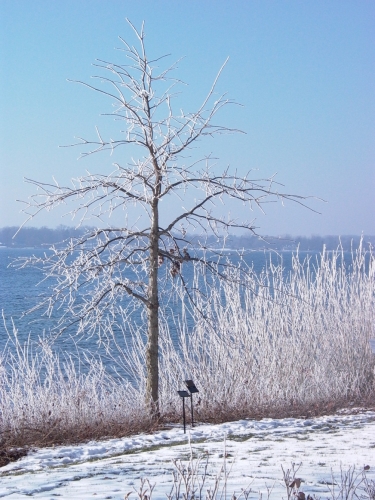The “do nothing” option for preparing your inland lake shoreline for winter
Homeowners with natural shorelines create “interest” in the winter landscape while providing important habitat.
 With the boating season winding down, lakefront property owners are taking a deep breath to enjoy lovely fall days on the lake. Those with natural shorelines may even be visited by migrating birds and butterflies.
With the boating season winding down, lakefront property owners are taking a deep breath to enjoy lovely fall days on the lake. Those with natural shorelines may even be visited by migrating birds and butterflies.
If you’ve created a no-mow zone, planted a native buffer strip or your shoreline has never been altered and the native vegetation is intact, congratulations! You have the “do nothing” option available to you, as there should be little to do to prepare for winter. Some property owners may wonder if they should cut down and “clean up” dead and dying vegetation. It’s recommended that native near-shore and shoreline vegetation be left standing and allowed to die down naturally. The seed heads of native flowers, rushes and grasses are an important food source for over-wintering birds. Plant material that breaks and falls down naturally provides organic matter, food and cover for other species that depend on the natural shoreline for refuge from winter winds, snow and ice. Dead leaves that have fallen into shoreline buffers also provide cover and protection. Never rake leaves into buffer strips or into the lake.
If you have installed bioengineered shoreline erosion control using some type of plant-based, biodegradable linear shoreline protection (such as coir fiber logs or brush bundles), maintenance prior to ice-in is highly recommended. Make sure that all stakes and ropes are snug, strong and intact to reduce the chance of damage by ice action. Even with low water levels in many lakes, ice chunks pushed by spring winds can pile up and rearrange linear shoreline protection necessary to protect native plantings during the establishment phase.
If you want to clean up your shoreline, waiting until spring is advised. Gentle spring raking of leaves and dead plant material out of no-mow zones and buffer strips allows the soil to warm up more quickly and jump start spring growth. Do not disturb dead aquatic plant material in the lake or on the lake bed or leaves that have naturally accumulated in near-shore areas over the winter. They provide important food sources and protection from spring wave action. Again, all bioengineering should be inspected at ice-out. Linear shoreline protection rearranged by ice action should be re-set to protect plantings from wind, waves and boat wake.
In addition to habitat, native shoreline plants create “interest” in the winter landscape. For more information about natural shorelines on Michigan inland lakes, please visit the website of the Michigan Natural Shoreline Partnership.



 Print
Print Email
Email


